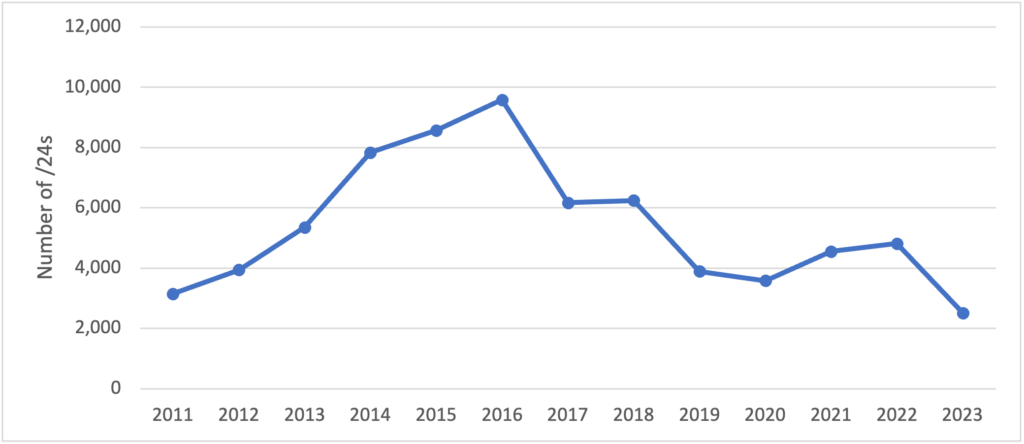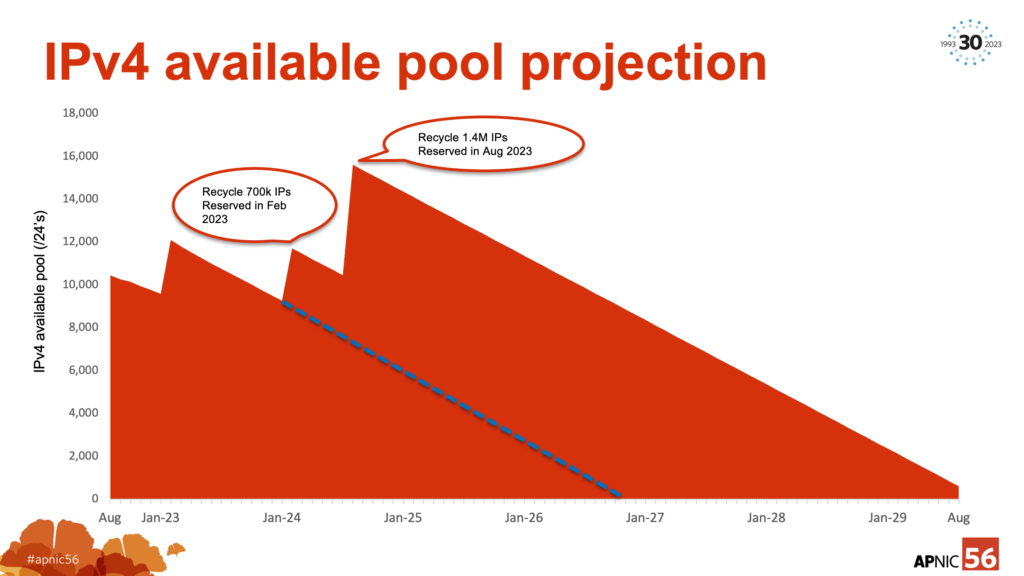
It has been over 12 years since APNIC began delegating IPv4 addresses from its final /8 (103/8) on 18 April 2011.
When the APNIC community discussed the final /8 policy (prop-062) in 2009, there was a widely held expectation that the 103/8 would last for around 10 years to help support the move to IPv6.
That estimate was relatively accurate, as APNIC will likely make its final delegations from 103/8 this week. At the time of writing, there were only 121 /24s, or 30,976 addresses left to delegate from 103/8.
Further IPv4 delegations will come from recycled address space from (mostly) non-103/8 ranges, as there are still almost 20,000 /24s left in APNIC’s available and reserved IPv4 pools (more on that in a moment).
Policy and 103/8
On 3 February 2011, ICANN/IANA allocated the 103/8 IPv4 block to APNIC, with delegations starting from this final /8 on 18 April. Each APNIC account holder could receive up to a /22 from 103/8 according to the final /8 policy.
Read more: The development of prop-062
In 2019, the maximum delegation size from final /8 changed from a /22 to a /23 (prop-127). This change extended the life of 103/8 for another two years. The chart below shows the impact of this policy change in slowing the consumption of 103/8.

IPv4 address space is still available
The exhaustion of 103/8 doesn’t mean that APNIC has run out of IPv4 or will stop delegating IPv4 addresses.
At the time of writing, there were 19,811 /24s or 5,071,616 IPv4 addresses left in APNIC’s available and reserved pools.
| Ranges | Available (/24s) | Reserved (/24s) |
| 103/8 | 121 | 1,459 |
| non-103/8 | 9,941 | 8,290 |
| Total | 10,062 | 9,749 |
A significant amount of this address space was recovered as part of the historical resources transition project that began in March 2022 and concluded at the end of August this year.
This work was in response to an Executive Council decision that historical resource holders in the APNIC region would need to become Members (or Non-Members) in order to receive registration services.
The project saw APNIC contact thousands of historical resource holders to provide transition options and to see if the historical IPv4 space was still in use or needed. There’s more background information on this project available here.
The results of the historical resources project were reported at APNIC 56:
- Total IPv4 addresses retained by custodians: 3,705,344
- Total IPv4 addresses recycled: 658,944
- Total IPv4 addresses reserved: 2,113,536 (around 700,000 in February 2023, and 1.4 million in August)
There are still approximately 200 cases — representing the balance of the 864,512 addresses identified at the start of the project — that have been absorbed into the APNIC Services team caseload. Among the reasons these cases remain open are complexities or dual claims that are not yet resolved.
The recovered IPv4 addresses from this project will be delegated according to the current policy. New members can still receive up to a /23 IPv4 from APNIC. New delegations from non-103/8 ranges are considered the same as those from the 103/8 range and are subject to the same five-year restriction before they can be transferred.
The future
If there are no further IPv4 policy changes and the current delegation trend remains the same, the depletion of APNIC’s available IPv4 will likely look like this, as presented at APNIC 56.

Go IPv6
While APNIC will still have IPv4 address space to delegate for another five years, the exhaustion of 103/8 is yet another reminder that it is time to start deploying IPv6, if your organization has not yet done so.
IPv6 capability for the Asia Pacific is 43%, so there is still more work. Learn more and see how other organizations have successfully deployed IPv6.
The views expressed by the authors of this blog are their own and do not necessarily reflect the views of APNIC. Please note a Code of Conduct applies to this blog.

> The exhaustion of 103/8 doesn’t mean that APNIC has run out of IPv4 or will stop delegating IPv4 addresses.
That sucks. APNIC should stop delegating IPv4 addresses.